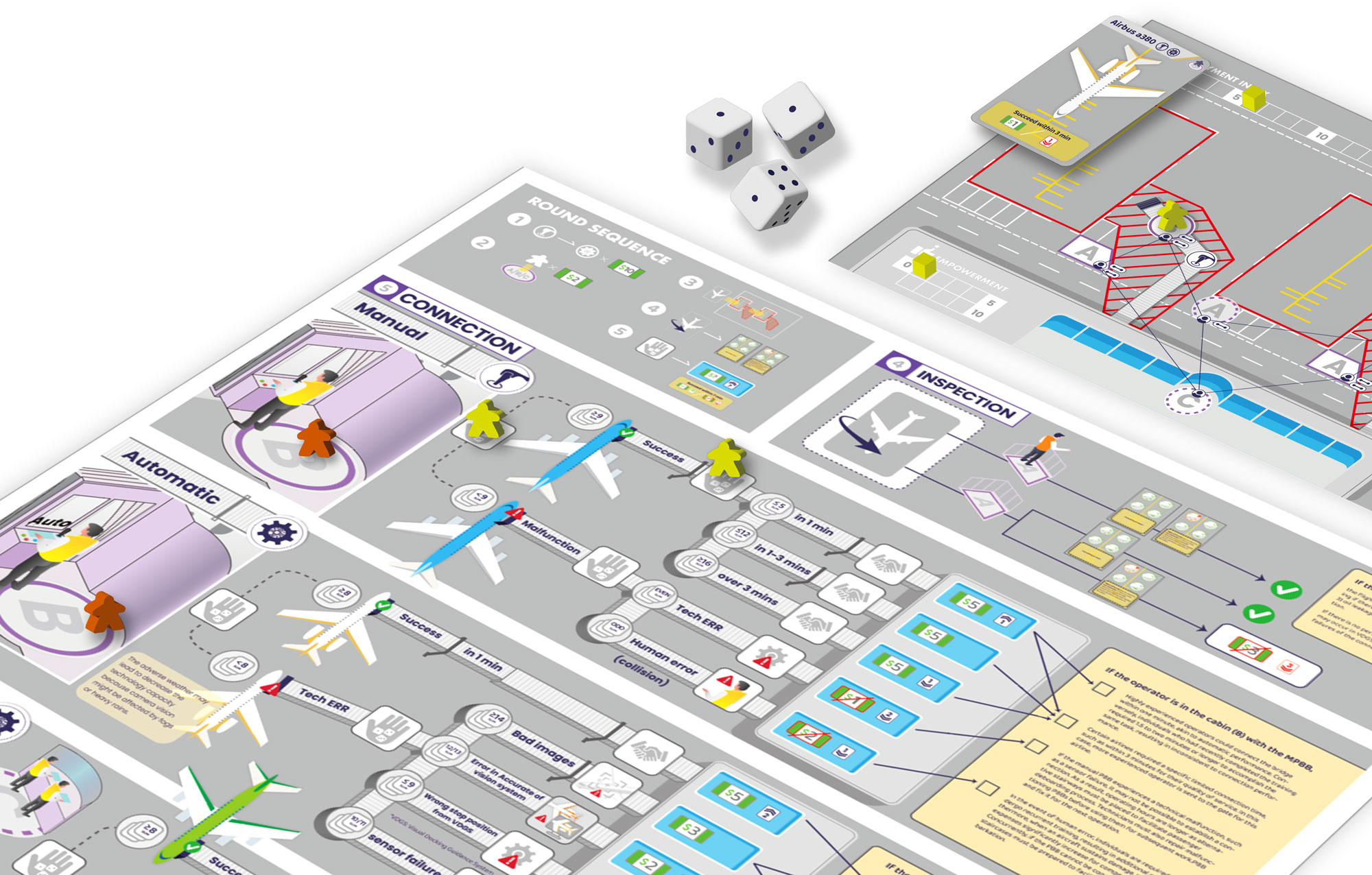

Framing a Guideline
for Balancing Task Delegation
of Human-Robot Collaboration
in Automation processes
A Case Study: Automatic Passenger Boarding Bridge in Amsterdam-based Airport Autonomous Airside Operation
Automation technology can bring numerous benefits. However, in practice, disentangling how the evolving Automated Systems (ASs) will transform human roles remains challenging, necessitating exploration of task delegation regarding which tasks can (or can’t) be delegated to ASs.
I investigated an organization’s perspective regarding the intricate dynamics of Human-Automation Collaboration (HAC) in the context of Passenger Boarding Bridge (PBB) operations in airports, resulting in
🎲 a decision-making board game as a speculative probe called PBB
📍a roadmap for a future vision
The outcomes can empower organizations with insights into the evolving nature of tasks for both humans and Automated Systems (ASs).
Category
Academic / Individual
Type
User Experience / Tech
Scale
500 x 707 (W x L, mm)
Period
Feb. 2023 – Aug. 2023
What I did
Design Research, Concept, Prototyping, Evaluation
Supervised by
Dr. Himanshu Verma
Dr. Eui Young Kim
MSc. Garoa Gomez-Beldarrain
Client
The Royal Schiphol Group
To what extent can humans delegate which tasks to Automated Systems (ASs)?
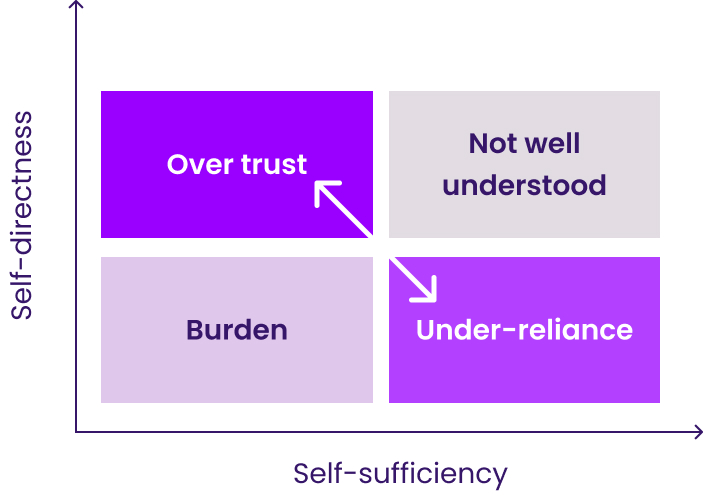
The advancement of automation technology has brought numerous benefits
(Hopko et al., 2022; Janssen et al., 2019; Omohundro, 2014) for manual work in organizations, such as the ability of robots to
- ⏰ increase efficiency and precision of operations (Jovanović et al., n.d.),
- 💪 handle heavy workloads (Beer et al., 2014),
- 🔁 perform repetitive tasks (Kadir et al., 2019), and
- ⚠️ operate in hazardous environments on behalf of humans (Hopko et al., 2022).
However, the evolved technologies challenge design and HCI research in disentangling how the emergence of Automated Systems (ASs) will transform human roles (Bradshaw et al., 2013), emphasizing the need to define concrete guidelines for task delegation between human workers and ASs (Liu & Zuo, 2011).
Project Overview
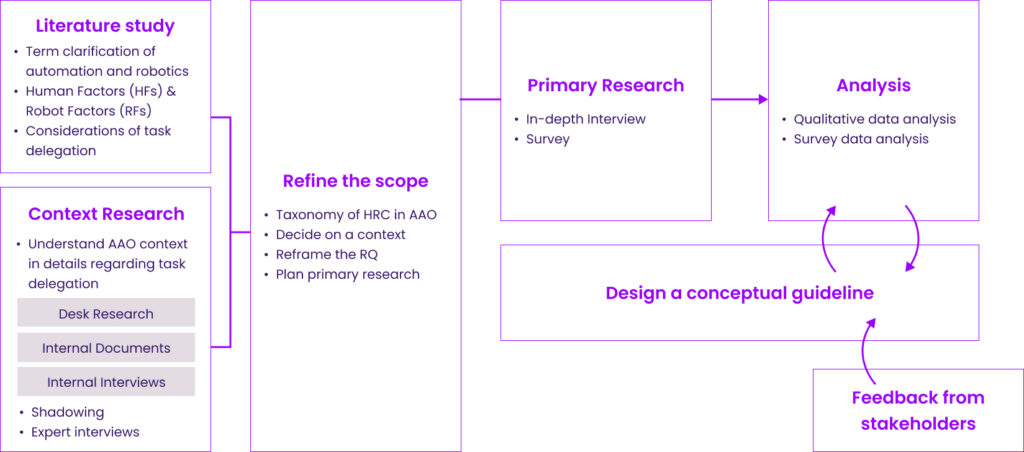
A case study of Passenger Boarding Bridge (PBB) in the airside operations
The research involves a case study in the context of Autonomous Airside Operations (AAO) at the Amsterdam Airport Schiphol (Figure 3), which innovates the turnaround procedure (Figure 4) for a timely and safe performance by using automation technology.
Among many steps in AAO, this study decided to focus on Passenger Boarding Bridge (PBB) (Figure 5) based on preliminary research including literature study, context research (i.e., shadowing(Figure 6)).
Primary Research
- In-Depth Interviews (N=6) analyzed with Reflexive Thematic Analysis (RTA, Figure 8)
- 3 Operators with MPBB or APBB operation experience
- 3 Decision-makers with knowledge of APBBs and influence of implementation/ development
- Survey (N=8, Figure 9)
- Operators
Research Question
“In the different PBB operation types (e.g., semi-auto controlled in a PBB, semi-auto controlled outside PBB), which tasks can be delegated to automated systems, and which tasks should be performed by humans?”
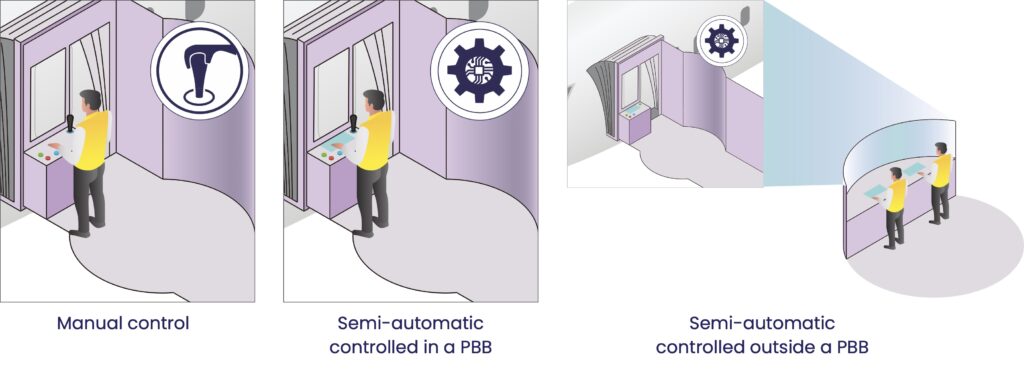
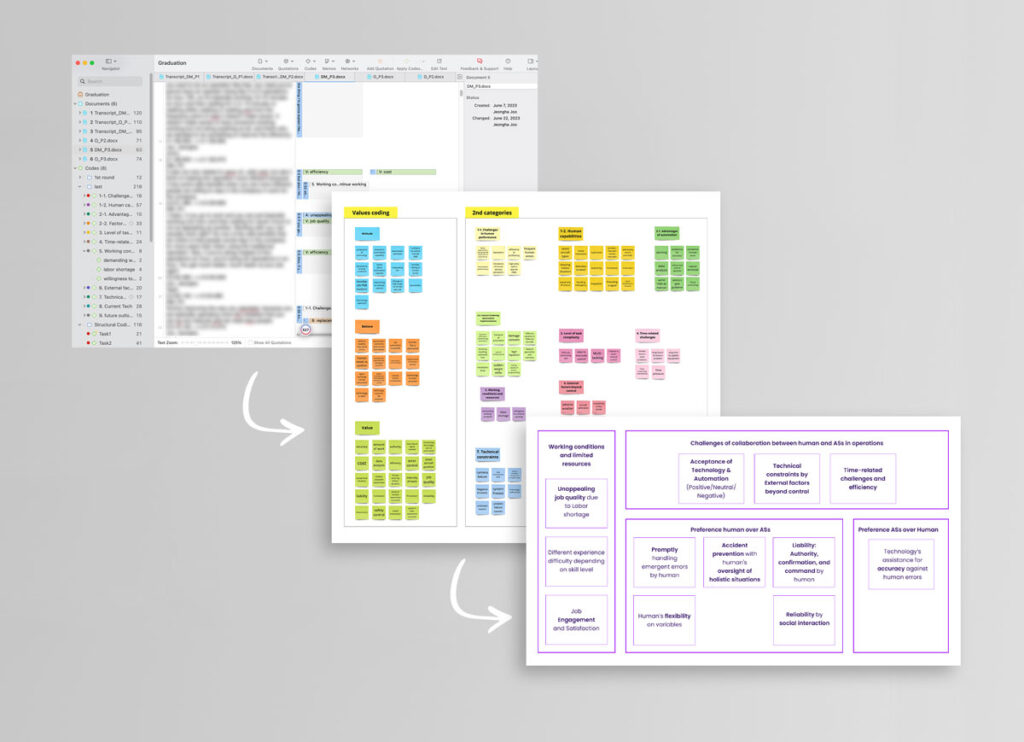
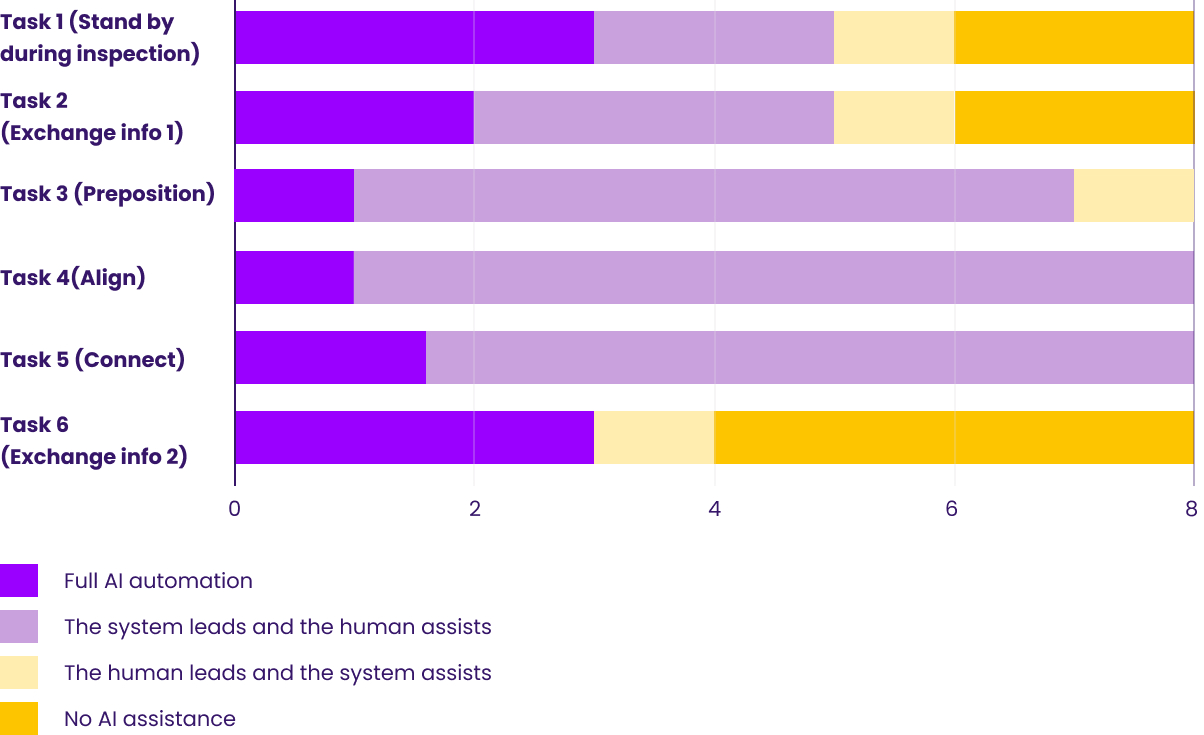
Objective:
- Discover correlations between the influential factors (e.g., human preferences, capabilities) and task delegation
- Find the spot of tensions in perspectives towards ASs between operators and decision-makers
Participants:
- Operators who have either MPBB or APBB operation experience, and
- Decision-makers who have knowledge of APBBs, and influence APPB implementation or development.
Protocols:
A semi-structured interview with open-ended questions
- Introduction: brief the purposes of the study with the consent form including objective, procedure, data management, and risks.
- Questions:
- How is your experience in operating MPBB? (was it positive/negative? and why?)
- If some errors occurred, what are they when comparing the two types?
- Why do they occur? Were they technical issues mainly? or human mistakes?
- How do you solve them? and How long does it take to solve it?
- Who takes control for these subtasks(sense,plan,action) in MPBB, how would it be in APBB? and why
- What if all the APBB is controlled in a remote control room, how would it be different? and how would you take control of these subtasks?
Data Analysis:
- Reflexive Thematic Analysis (RTA (Clarke & Braun, 2014) of transcripts
- Combined RTA with the Values coding and the Structural coding (Saldaña, 2009)
Objective:
- Same objectives with in-depth interviews
- Triangulate the qualitative results
Participants (N=8):
- (N=8) Operators who have either MPBB or APBB operation experience, and
- (N=1) Decision-makers who have knowledge of APBBs, and influence APPB implementation or development. (Omitted in the data)
Main Questions:
- Human Preferences
- For each of the following statements (motivation, difficulty, risk, and trust), please indicate the extent to which you agree or disagree for the above task in operating APBB: (five-point Likert scale)
- Degree of delegation
- For operators: if you were to do the given (above) task, what level of AI/machine assistance would you prefer?
- For managers: If you were to ask someone to complete the given (above) task, what level of AI/machine assistance would you prefer?
12 themes with 4 dimensions of considerations in task delegation
Figure 7 illustrates a similar tendency in willingness of delegating tasks to ASs. In task 3, 4, and 5, which require more precise measurement skills, the majority of participants lean towards delegating these tasks to ASs as assistants. In contrast, task 1, 2, and 6, which involve a task such as “Inspection” and “exchange information”, exhibit diverse preferences in the delegation.

Figure 8. Task delegability combining results of all task (N=8)
Implications
Ideal for high-precision task delegation to ASs while assigning information exchange tasks to humans
The main insights indicate that high-precision tasks are identified as potential candidates for AS delegation, while tasks requiring clear communication and meticulous inspection align better with human management. The study underscores the significance of effective information exchange, emphasizing the multifaceted roles of humans beyond mere data exchange.
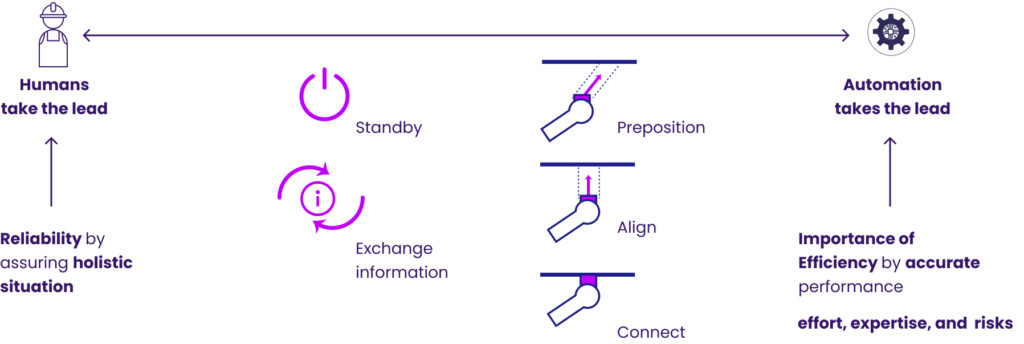
Design Direction
Simulating possible or probable scenarios in the transition of different types of PBB control is important to design so that organizations can strike the balance of delegation between human tasks and ASs tasks by understanding holistic situations. Therefore, the design direction includes confronting
- different perspectives of the decision-making process in task delegation,
- two different values (i.e., the importance of reliability assuring a holistic situation and the importance of efficiency by accuracy), and
- diverse scenarios caused by decision-making and different variables.
Conceptualization
A decision-making board game
as a speculative probe: PBB
“Not in trying to predict the future but in using design to open up all sorts of possibilities that can be discussed, debated, and used to collectively define a preferable future for a given group of people: from companies, to cities, to societies.” _Speculative Design (p. 6)
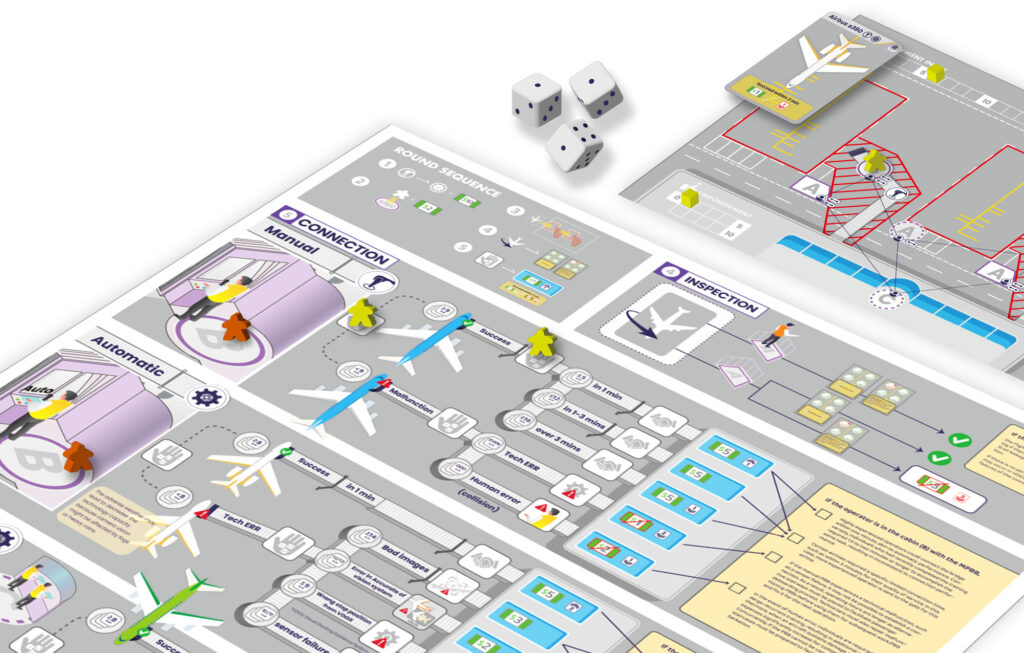
Serving as a speculative probe, the board game has been crafted to discuss the controversial values and perspectives and engage diverse stakeholders in an open dialogue centered around automation technology by visualizing all possible scenarios in operating APBBs.
It’s a balancing game regarding how players decide on the ratios of the number of workers and automation.
There are three different locations that workers can be allocated: B is PBBs cabin, A is on the ground, and C is in the remote room. In particular, worker in area A inspects the aircraft conditions. For example, when flipping flight cards show issues on the back side without a person in A area, you have to pay costs due to decreasing efficiency.
Therefore, based on where the workers are located and the types of PBBs in operations, a certain scenario begins.

For instance, when choosing the manual type, you put one meeple this area. And you roll the dice and sum up the number 8, leading to malfunction. And then you throw one more dice to see if it will be a technical or human error. In this case, the even number came out, leading to a technical error, so the player needs to pay following costs.

In the automatic situation, certain weather conditions decrease the success rate. Moreover, APBB with operators’ control does not have collision scenarios, but the full automatic version has a dramatic situation leading to the lowest efficiency and the highest costs.
Depending on the scenario, the rewards and costs vary, and all the possibilities and cases are designed based on primary research.
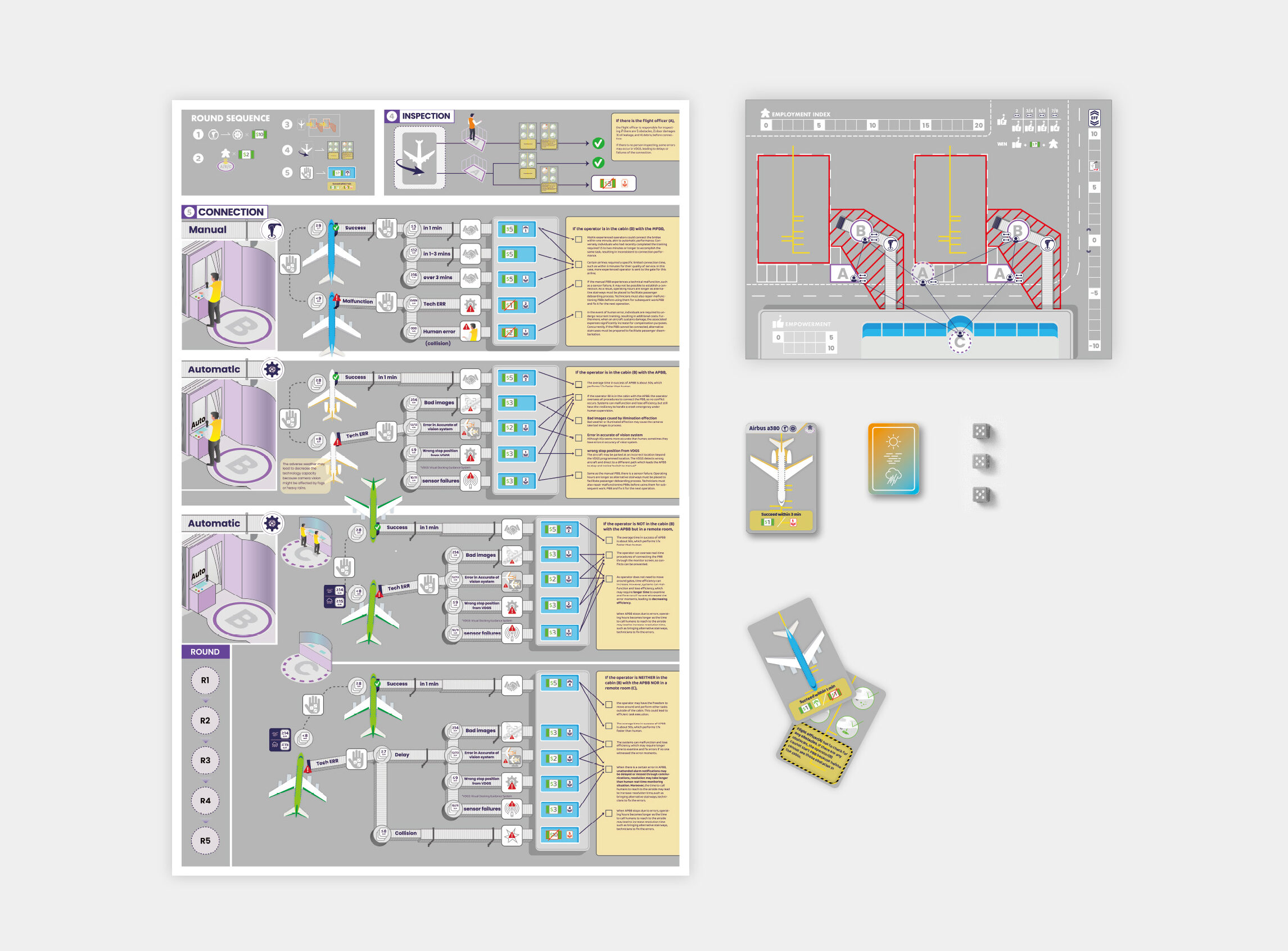
Evaluation
3 sessions:
- Session 1: 3 decision-makers
- Session 2: 3 operators
- Session 3: Mixed with 1 operator and 2 decision-makers
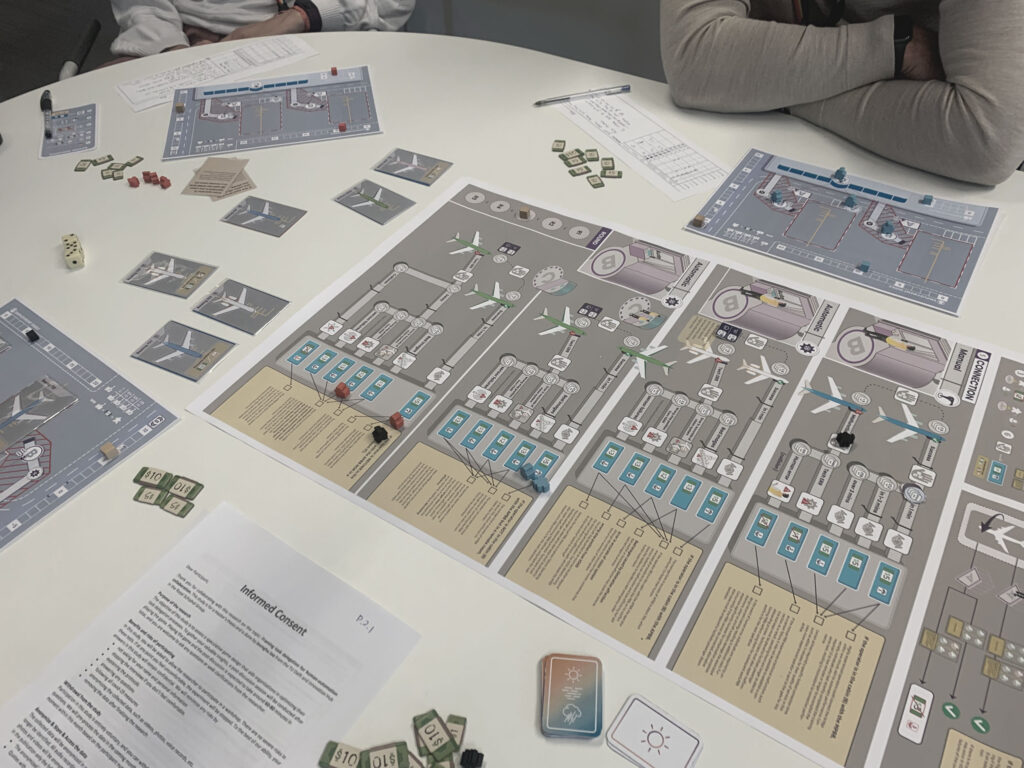
Reflecting
The stakeholders could confront different perceptions on automation and efficiency, while empathizing others’ perspectives. The game intervention also provoked trade-off experiences between two different values by balancing risks and rewards. It also helped the stakeholders to envision possible scenarios considering human values against using automation and to engage in discussions.
However, a quick action plan could be helpful for the organizations to have an overview on this game, which led to developing a roadmap for the future vision.
Question 1.
Can the design help participants to confront different perspectives of the decision-making process in task delegation?
Confront different perceptions on automation and efficiency, while empathizing others’ perspectives
Confronting diverse perceptions on automation
“I rather have manual bridge with manual thing (control) than the automatic doing manual. It’s not, it’s not my favorite.” _O4
“…we have to remote. We do like to..”_DM2
Exploring Efficiency Perceptions
“I like manual because automatic is too slow” _O3
“I think maybe empowerment even has a slightly interrelation with efficiency.” _DM3
Empathizing other perspectives
Descriptions of failures as “terrible” and “terrifying.”
“then the job just gets boring.” _DM1
Question 2.
Can the design provoke participants to confront two different values between the importance of reliability assuring a holistic situation and the importance of efficiency by accuracy?
Trade-off experiences between two different values by balancing risks and rewards
Trade-off experience between efficiency and humans’ oversight
“I took a huge risk by having no one check the airplane.”_DM1
“This is more efficient for money. But this is more efficient for the whole”_O4
Balancing of Risks and Rewards
“It makes you think about the risk and reward. So that’s what I really liked.” _DM2
Question 3.
Can the design help organizations envision possible/probable scenarios of how HAC may be changed with different variables?
Envisioning possible scenarios considering human values, need to take actions for the scenario
Simulating different scenarios with reflection on reality
Envisioning hybrid remote control scenario
The importance of humans’ inspection and flexibility
Needs for means to exchange information seamlessly
“we have to knock we are the ones that say it is now safe for you to open the doors. Who’s going to do that? (if being automatic)” _O1
Implementation and management planning
Highlighting the need for new safety measures, extensive sensor deployment
Question 4.
How can the design be practical for decision-makers to open up decision-making discussions in task delegation?
Engaging in discussions with collaborative inquiry
Enjoyment
Applicability in Organizations
Utilizing the scenario probabilities to analyze operational efficiency through empirical testing.
Potential for strategic decision-making, risk assessment
Fostering Collaborative Inquiry
The most number of questions occurred among participants in the mixed group (Session 3)
A Future Roadmap
A hybrid Human-Automation Collaboration (HAC) under humans’ holistic oversight,
integrating virtual remote control into operations
A Future Roadmap
A hybrid Human-Automation Collaboration (HAC) under humans’ holistic oversight, integrating virtual remote control into operations

Horizon 1.
Expanding APBBs, yet Manual controls are prominent types
Horizon 2.
Mixed with MPBBs and APBBs, as APBBs are expanded with remote control system
Horizon 3.
APBBs are dominant with remote controls although few MPBBs are still available.
Takeaways
Challenges in smooth collaboration with multi-stakeholders
The challenges of setting up the in-depth interviews and surveys within specific target groups from different organizations enabled me to sharpen my ability in management and communication for effective collaboration.
Integrating empirical and theoretical insights
The primary contribution of this research lies in its unique approach of merging empirical insights with theoretical perspectives. Within the mobility community, particularly in the aviation industry, this study offers valuable empirical findings from the AAO context.







